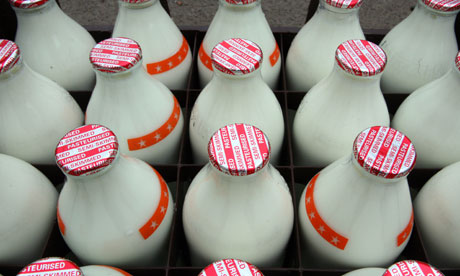
Was western civilisation built on milk? Cultures thrive when people have to spend less of their time on the business of finding nourishment. For Eurasian peoples, who could digest animal-derived lactose more easily than those in Africa or the far east, cows, goats and sheep have long been convenient providers of cheap fats, vitamin D and calcium. Where civilisation first set up its stall in the near east, there are accounts of dairying. Records of milk production occur in the cuneiform tablets of the Uruk period of 3,000 years ago, and in Sumerian and Babylonian sources.
Milk, says Deborah Valenze in this fascinating history, has been crucial to survival in many societies. In all of them, it came in a complex cultural package. "Every chapter of its history has involved a kind of cosmic drama, in which the magic or potency associated with the liquid food comes urgently at issue."
The notion of milk's potency as a precursor or catalyst of civilisation has often proved controversial. In 1918, an American dietary scientist and columnist named Elmer McCollum claimed that the "milk-using peoples" were more "advanced" in every sphere. They were taller, longer-lived and also "more aggressive". Herbert Hoover was among his supporters and within the next decade the making of milk products in the US went up by a third.
Religious superstitions promoted and confused milk drinking from the beginning and still do so. Quite frequently, parts of India, now the world's biggest producer, run out of milk, when rumours spread that Ganesha, the elephant-headed god of wisdom, wishes to "drink" some. When this happened last September, too late for this book, an estimated 1 million litres were fed to Ganesh statues. The conflation of milk with blood is ancient: the Galenic school believed that excessive menstruation could be solved by draining milk from the breasts and that blood, semen and milk were all variants of the same liquid.
But in medieval times, milk was also imbued with virtue and spiritual knowledge. With such confusions, it is hardly surprising that the most controversial piece of Christian milk iconography concerns the legend of St Bernard, fed by a vision of the Virgin Mary from her own breast. These taboos are still current, according to Valenze. She asks why we should feel revulsion at the idea of eating cheese made from human milk – why indeed?
Britain's own muddles over milk have been chiefly medical. By the 17th century, the rich took milk in huge quantities to address ailments from melancholy to bowel complaints. Meanwhile, "white meats", the easily transported fruits of milk such as butter and cheese, were the principal source of nutrition for the poor. Seen through a milk historian's eyes, Pepys's diaries tell of an orgy of milk product consumption: when the Great Fire of London threatened his home in Seething Lane, the treasures he buried in the garden for safety were his papers, his wine and "my parmazan cheese".
Today, we are no less exercised by myths and quasi-scientific beliefs about milk. Health fears and worries about the side-effects of industrialised production have meant declining consumption for 40 years in Europe. A peek into the average British fridge will find white-coloured water in bottles: heat-treated, filtered, reduced fat milk, much of the nutrients that kept previous generations from rickets and nutrition removed.
The only disappointment in Valenze's book is that after telling of 5,000 years of ups and downs in the fortunes of milk, she doesn't venture far into milk's current decline. Traditional dairy farming, which shaped the countryside of northern Europe more than any other human activity, is disappearing. Thousands of British dairy farmers have gone out of business in the last decade, chiefly because we (or the supermarkets) won't pay enough for our pint. Unless this changes, the future is the vast milk factories already dominant in the US, filled with hybrid cows which never see a grassy pasture and work only two or three years before being destroyed. Daisy the dairy cow, with a straw hat in a field of clover, gave milk for 10 years or more. As one study cited by Valenze tellingly reveals: "Cows with names give more milk than cows without them."

